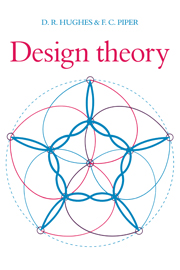Introduction
Published online by Cambridge University Press: 08 January 2010
Summary
The subject of design theory has grown out of several branches of mathematics, and has been increasingly influenced in recent years by developments in other areas. Its statistical origins are still evident in some of its standard terminology (thus ‘ν’ for the number of points in a structure comes from ‘varieties’). Today it has very fruitful connections with group theory, graph theory, coding theory and geometry; these ties have been two-way, by and large.
We have attempted in this book to lay the groundwork for an understanding of designs, with advanced undergraduate or postgraduate students in mind. Our aim is to prepare the reader to use designs in other fields or to enter the active field of designs themselves. Finite projective and affine geometries are central to design theory, and are introduced early in the book. Since classical geometry is a very large field, the student with a background in this subject will be at an advantage, but we have tried to present a treatment sufficiently self-contained to answer the needs of a reader with a reasonable knowledge of linear algebra. The subject of symmetric designs is also introduced early, and its important aspects (the Bruck–Ryser–Chowla Theorem, Singer groups and difference sets, Hadamard 2-designs, etc.) are developed. The first four chapters, covering basic definitions, geometry and symmetric designs, are designed to be part of any course based on the book.
The other four chapters can be studied more or less independently of one another.
- Type
- Chapter
- Information
- Design Theory , pp. vii - viiiPublisher: Cambridge University PressPrint publication year: 1985

